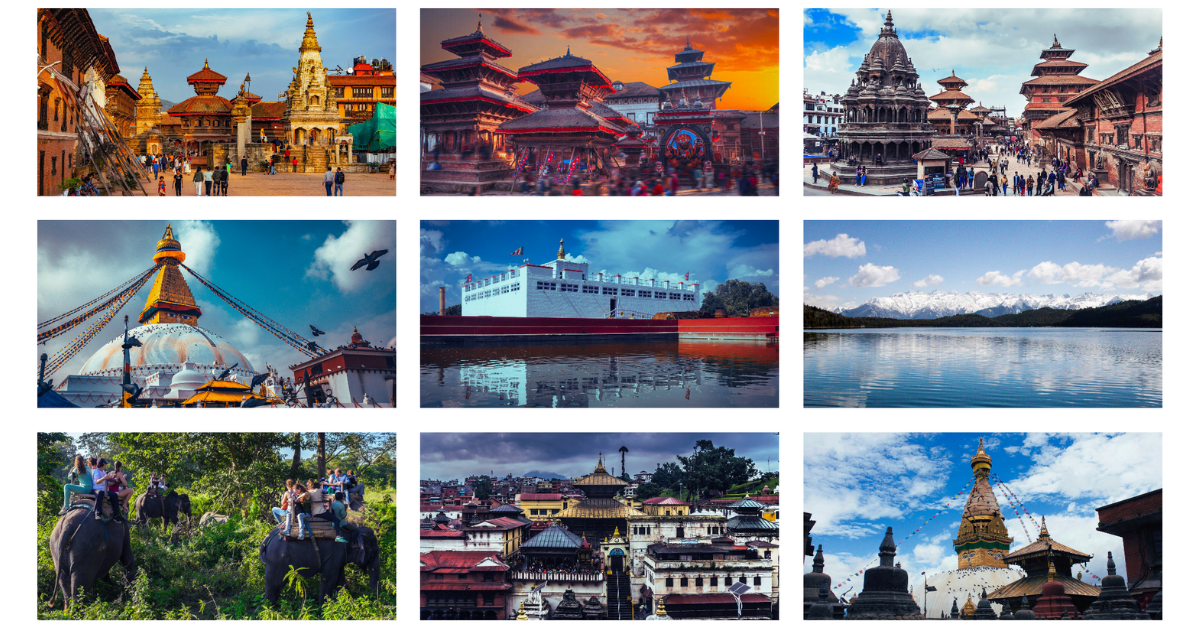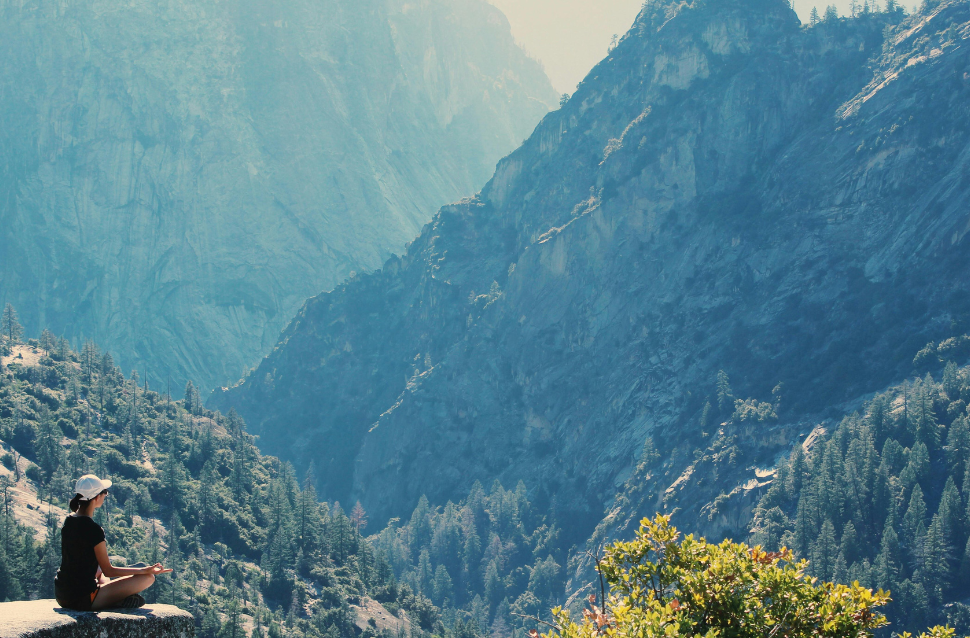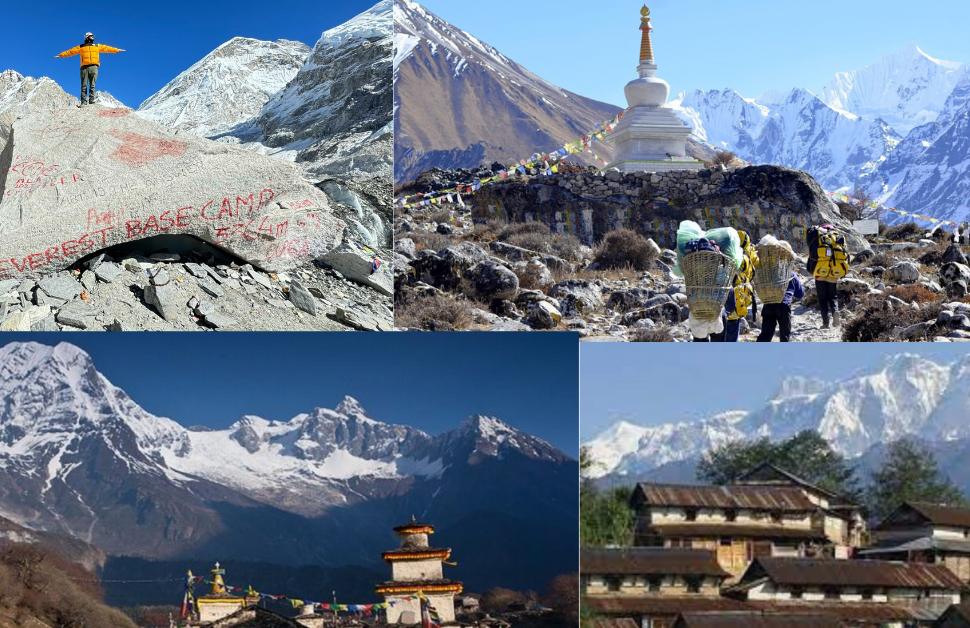Nepal is a land celebrated for its stunning landscapes and rich cultural heritage. UNESCO has listed 10 sites of Nepal as World Heritage Sites that highlight its historical significance and natural beauty. These sites showcase a blend of ancient temples, palaces, and majestic mountain ranges, each narrating a unique story of the past. These World Heritage Sites not only preserve Nepal’s glorious past but also promote sustainable tourism and conservation efforts.
In this blog, we will explore the top ten UNESCO World Heritage Sites of Nepal, highlighting their significance, unique features, and the experiences they offer to travelers. Whether you are an adventure enthusiast, a history buff, or someone seeking spiritual enlightenment, Nepal’s World Heritage Sites promise to leave you with unforgettable memories and a deeper understanding of the nation’s cultural fabric.
1. The Kathmandu Durbar Square
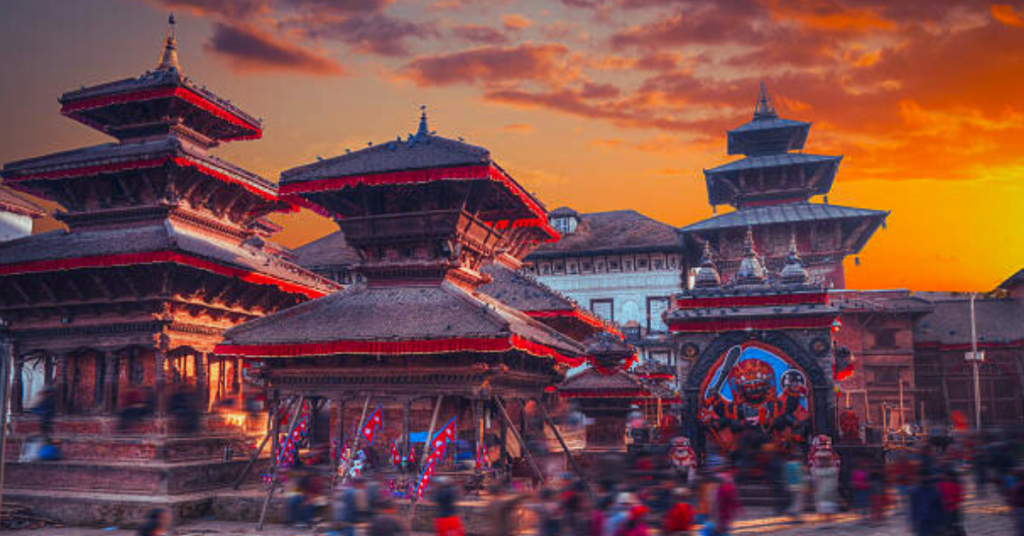
Kathmandu Durbar Square, a UNESCO World Heritage Site, is a historic plaza located in the heart of the capital city holding the status of a historical epicenter. The square is home to various temples, palaces, and courtyards, showcasing the architectural brilliance of the Malla period (12th to 18th centuries). Notable structures include the Hanuman Dhoka Palace, Taleju Temple, and the Kumari Ghar, where the living goddess, or Kumari, resides. Visitors can witness traditional ceremonies, explore the rich history, and experience the vibrant culture of Kathmandu at this iconic site.
Unique Features
The square is adorned with an impressive array of temples, palaces, and courtyards, each reflecting intricate craftsmanship. Key highlights include:
- Hanuman Dhoka Palace: The former royal palace complex, featuring exquisite wooden carvings and courtyards. It houses the King Tribhuvan Memorial Museum, showcasing the history of the Shah dynasty.
- Kastamandap: A wooden pagoda believed to be built from the timber of a single tree, this structure is not only architecturally unique but also holds religious significance, as it is dedicated to the god Gorakhnath.
- Kaal Bhairav: A massive stone statue of the fierce god Bhairav, known as the “Black Bhairav,” which serves as a guardian deity of the square.
- Vishvakarma Temple: Dedicated to the god of creation and architecture, this temple features intricate carvings and reflects the divine craftsmanship of local artisans.
Experiences for Travelers
Visitors to Kathmandu Durbar Square are treated to an immersive cultural experience that captivates the senses. Here’s what travelers can expect:
- Cultural Exploration: Wandering through the square, travelers can observe the harmonious blend of Hindu and Buddhist traditions. The vibrant atmosphere is alive with local rituals, festivals, and daily activities that offer a glimpse into the lives of the Nepali people.
- Art and Architecture: The intricate woodwork and elaborate stone carvings provide ample opportunities for photography and admiration. Travelers can appreciate the craftsmanship of local artisans while exploring the many shrines and temples.
- Local Cuisine: The surrounding area is home to numerous eateries and stalls offering traditional Nepali dishes. Travelers can indulge in local delicacies such as momo (dumplings), dal bhat (rice and lentil soup), and Newari specialties, enhancing their cultural experience.
- Festivals and Events: Depending on the time of visit, travelers may have the chance to witness vibrant festivals celebrated in the square, such as Indra Jatra, which features traditional dance, music, and rituals.
- Shopping and Souvenirs: The nearby Thamel area is known for its shops selling handicrafts, textiles, and souvenirs. Visitors can take home unique artifacts that reflect the rich culture of Nepal.
2. Swayambhunath Stupa (Monkey Temple)
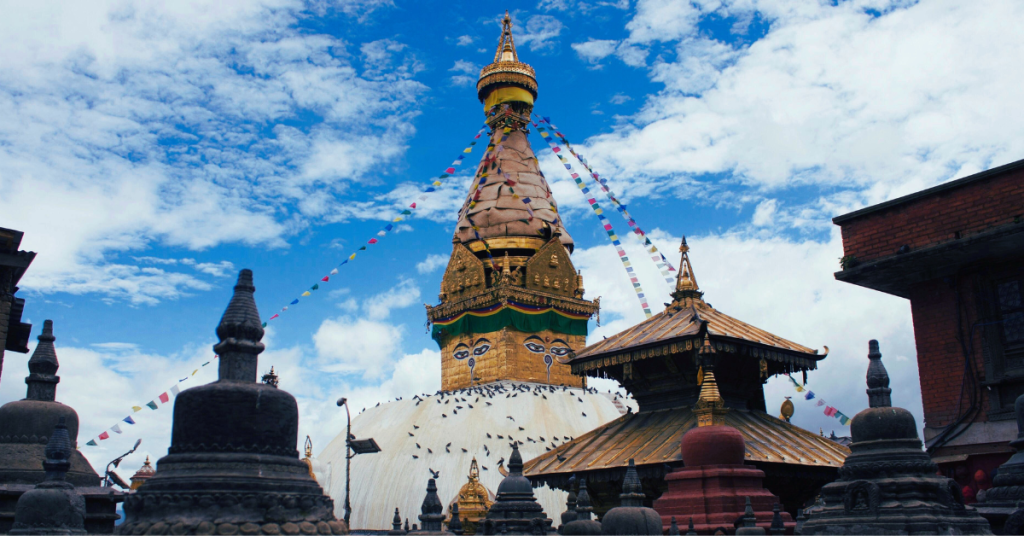
Swayambhunath, often referred to as the Monkey Temple, is an ancient religious complex perched atop a hill overlooking Kathmandu. This stupa, dating back over 2,500 years, features a harmonious blend of Buddhist and Hindu elements. The name “Swayambhunath” translates to “self-existent,” referring to the myth that the stupa arises naturally from the ground. Swayambhunath Stupa is a beautiful place where stories and teachings of Buddha are narrated. The iconic eyes of Buddha painted on the stupa symbolize wisdom and compassion. Visitors are treated to breathtaking panoramic views of the Kathmandu Valley while observing the lively monkeys that inhabit the area. The vibrant prayer flags and spiritual ambiance create an unforgettable experience.
Unique Features
Swayambhunath Stupa is renowned for its striking architecture and intricate artistry. Key highlights include:
- The Stupa: At the center of the complex is the iconic stupa, topped with a golden spire adorned with the eyes of Buddha, symbolizing wisdom and compassion. The stupa’s dome represents the universe, while the square base signifies the Earth.
- Buddhist and Hindu Shrines: Surrounding the stupa are numerous shrines, temples, and images dedicated to various deities. Among them, the temple of Harati Devi is particularly popular among locals who worship her as the protector of children.
- Prayer Wheels: The complex features many prayer wheels, inscribed with mantras that visitors can spin as they walk by, contributing to their spiritual merit.
- Buddhist Flags: Colorful prayer flags flutter in the wind around the site, each carrying prayers and blessings to be carried by the breeze.
Experiences for Travelers
Visitors to Swayambhunath Stupa are treated to a multifaceted cultural and spiritual experience. Here’s what travelers can expect:
- Scenic Views: The stupa is perched atop a hill, providing breathtaking panoramic views of the Kathmandu Valley. The ascent to the stupa involves climbing a series of steps, where travelers can enjoy the natural beauty and serenity of the surrounding landscape.
- Wildlife Encounters: The site is affectionately known as the Monkey Temple due to the presence of playful monkeys that inhabit the area. Travelers can observe these curious creatures interacting with visitors and exploring the grounds, adding a lively element to the experience.
- Spiritual Reflection: The tranquil atmosphere and spiritual significance of the site encourage reflection and meditation. Visitors often take time to sit quietly, absorbing the peaceful ambiance and connecting with the spiritual essence of the stupa.
- Cultural Interaction: Travelers may encounter local monks and devotees engaging in rituals and prayers. This provides a unique opportunity to learn about the practices and beliefs of the Buddhist community in Nepal.
- Photography Opportunities: With its stunning architecture, vibrant prayer flags, and scenic backdrop, Swayambhunath offers countless opportunities for photography, making it a favorite spot for travelers and photographers alike.
3. Pashupatinath Temple
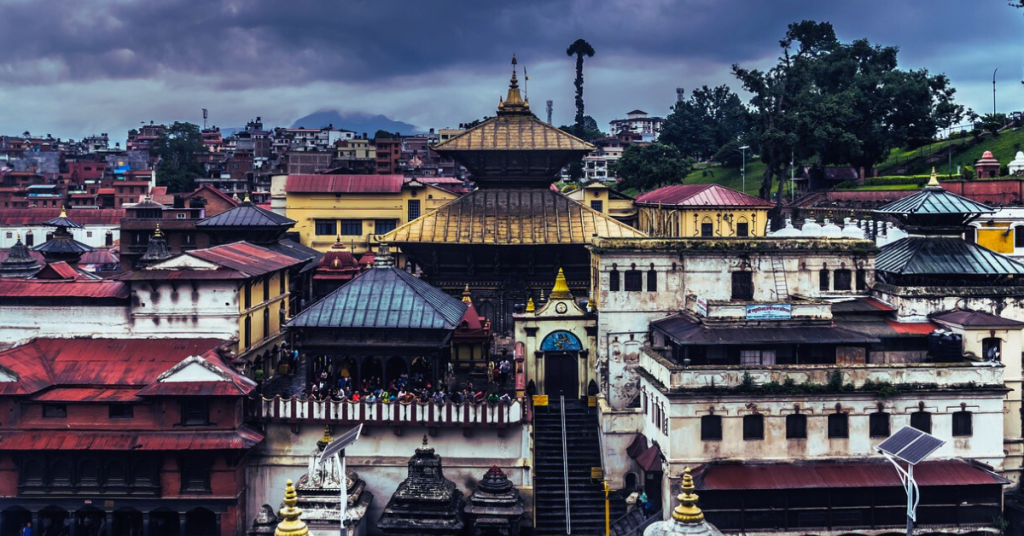
Pashupatinath Temple, located on the banks of the Bagmati River, is one of the most significant Hindu temples in the world. The temple is believed to date back to the 5th century, though it has undergone numerous renovations and expansions over the centuries. Dedicated to Lord Shiva, this sacred site attracts thousands of pilgrims and tourists alike especially during the auspicious festival of Maha Shivaratri. The temple complex is known for its stunning architecture, adorned with intricate carvings and golden roofs. Visitors can witness various rituals and ceremonies, including the traditional cremation rites performed along the riverbanks. The spiritual atmosphere and cultural significance make Pashupatinath a pivotal World Heritage Site.
Unique Features
Pashupatinath Temple is renowned for its stunning architecture and vibrant rituals. Key features include:
- The Main Temple: The temple’s central structure is a magnificent pagoda-style building adorned with intricate wood carvings and a distinctive golden roof. The temple houses a sacred linga (phallic symbol of Shiva) that is worshiped by devotees.
- Shiva Lingas: Within the temple complex, there are numerous shrines dedicated to different manifestations of Lord Shiva, including various shiva lingas, each representing different aspects of the deity.
- Sacred River: The Bagmati River, flowing beside the temple, is considered holy by Hindus. It plays a significant role in the rituals and ceremonies conducted at the temple.
- Sadhu Community: The temple complex is home to many Sadhus (holy men) who have renounced worldly life. Visitors often encounter these ascetics, who can be seen meditating, performing rituals, or sharing their spiritual insights.
Experiences for Travelers
Travelers visiting Pashupatinath Temple can expect a profound and immersive cultural experience. Here’s what you can look forward to:
- Spiritual Atmosphere: The temple exudes a deep sense of spirituality, making it an ideal place for reflection and meditation. Visitors can witness various rituals and ceremonies that take place throughout the day, including prayers, offerings, and aarti (ritual of light).
- Cremation Ghats: The temple’s location along the Bagmati River includes several ghats (steps leading to the river) where cremation ceremonies are performed. Observing these ceremonies can be a poignant experience, offering insight into Hindu beliefs about life, death, and the afterlife.
- Cultural Interaction: Travelers have the opportunity to engage with local devotees and Sadhus, learning about their practices, beliefs, and the significance of the rituals performed at the temple.
- Festivals and Events: If your visit coincides with significant Hindu festivals, such as Maha Shivaratri, you’ll experience the temple at its most vibrant. The temple is adorned with flowers and lights, and thousands of devotees gather to offer prayers, creating a festive and lively atmosphere.
- Photography Opportunities: The stunning architecture, vibrant ceremonies, and picturesque surroundings make Pashupatinath Temple a favorite spot for photographers. Capturing the temple against the backdrop of the Bagmati River and the surrounding hills provides memorable images.
4. Boudhanath Stupa

Boudhanath Stupa is one of the largest stupas in Nepal, offering a unique insight into Tibetan Buddhism and culture. This UNESCO World Heritage Site is characterized by its massive mandala and serene ambiance. It is believed to have been built in the 5th century, making it one of the oldest stupas in the world. The stupa is surrounded by numerous monasteries and shops selling traditional Tibetan handicrafts. Visitors can engage in the spiritual practice of circumambulating the stupa while soaking in the vibrant atmosphere filled with prayer flags and chanting monks. The stupa serves as a focal point for the local Tibetan community, hosting various rituals and ceremonies. It plays a vital role in the preservation of Tibetan Buddhism and culture, especially after the Chinese occupation of Tibet in the 1950s, which led to an influx of Tibetan refugees into Nepal.
Unique Features
Boudhanath Stupa is renowned for its striking architecture and vibrant atmosphere. Key features include:
- The Stupa Structure: The stupa itself is a massive mandala, standing at an impressive 36 meters high. It is adorned with a large white dome that represents the mind of Buddha and is topped with a golden spire that symbolizes the unity of the Buddha’s teachings.
- Eyes of Buddha: One of the most distinctive aspects of Boudhanath Stupa is the pair of painted eyes on the four sides of the stupa, known as the “All-Seeing Eyes.” These eyes represent the omnipresence of the Buddha, reminding visitors to be mindful and aware.
- Surrounding Monasteries: The stupa is encircled by numerous monasteries, shops, and cafes, providing a vibrant cultural atmosphere. The presence of monks and pilgrims adds to the spiritual ambiance of the site.
- Prayer Wheels and Flags: Surrounding the stupa are large prayer wheels that devotees spin as they walk clockwise around the stupa, chanting prayers. Colorful prayer flags flutter in the breeze, adding to the vibrant setting and symbolizing the spreading of goodwill and compassion.
Experiences for Travelers
Visitors to Boudhanath Stupa can immerse themselves in a rich cultural and spiritual experience. Here’s what you can look forward to:
- Kora (Circumambulation): Engaging in the traditional practice of kora, or circumambulating the stupa, allows visitors to participate in a time-honored ritual while soaking in the spiritual energy of the site. Walking around the stupa, you’ll encounter fellow pilgrims and experience a sense of unity in devotion.
- Cultural Interaction: Travelers can interact with local Tibetan families, monks, and shopkeepers who contribute to the vibrant culture surrounding Boudhanath. Many local shops sell traditional handicrafts, thangka paintings, and prayer beads, providing a perfect opportunity to bring home a piece of Tibetan culture.
- Meditation and Mindfulness: Boudhanath Stupa is an ideal place for meditation and reflection. Several monasteries in the area offer meditation classes and retreats for those looking to deepen their understanding of Buddhist practices.
- Festivals and Events: If you visit during significant Buddhist festivals, such as Losar (Tibetan New Year) or Buddha Jayanti (Buddha’s birthday), you will witness vibrant celebrations filled with music, dance, and religious rituals, providing a deeper insight into the local culture.
- Culinary Delights: The area around Boudhanath is home to many restaurants and cafes offering delicious Tibetan cuisine, including momos (dumplings) and thukpa (noodle soup). Enjoying a meal while overlooking the stupa creates a memorable dining experience.
5. Bhaktapur Durbar Square
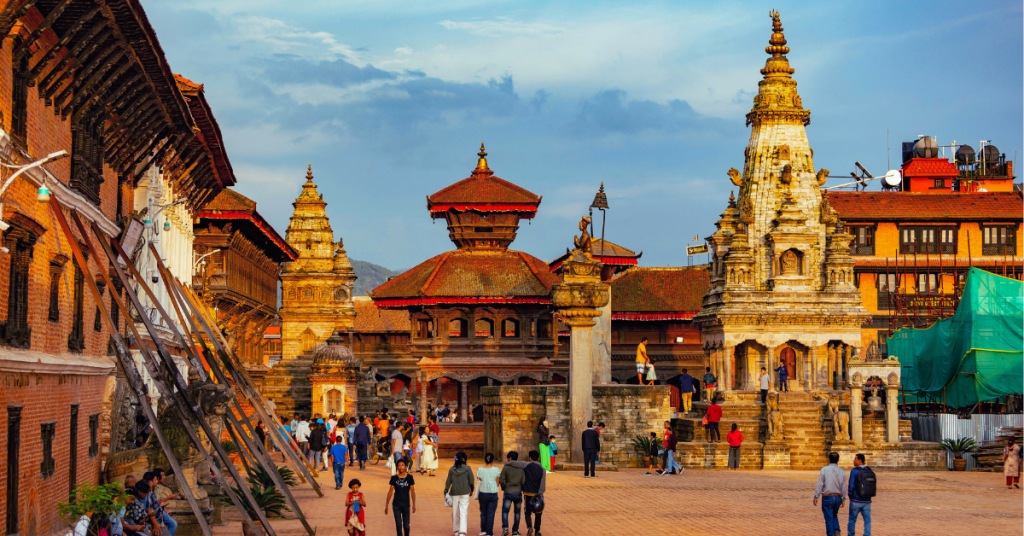
Bhaktapur translates to “The City Of Devotees” and served as the capital of Nepal during the Malla Dynasty. Bhaktapur Durbar Square is a UNESCO World Heritage Site that encapsulates the charm of medieval Nepal. The square is lined with beautifully preserved temples, palaces, and courtyards, showcasing the artistic brilliance of the Malla dynasty. Notable structures include the 55-Window Palace, Vatsala Temple, and the iconic Nyatapola Temple, which stands as a testament to Bhaktapur’s rich history. Visitors can indulge in local delicacies, shop for traditional crafts, and immerse themselves in the vibrant culture of this ancient city.
Significance
Bhaktapur, meaning “City of Devotees,” served as the capital of Nepal during the Malla dynasty and continues to be a hub of traditional Nepalese culture. The Durbar Square, a central point of the city, holds immense historical and cultural significance, with its numerous temples, palaces, and squares reflecting the architectural splendor of the Malla period. The square not only represents the artistic prowess of its time but also functions as a center for religious and cultural activities, making it a living heritage site.
Unique Features
Bhaktapur Durbar Square is renowned for its exquisite architecture and artistic details. Key features include:
- Vatsala Temple: This intricately carved temple, dedicated to the goddess Vatsala, showcases stunning stone sculptures and elaborate woodwork, making it a prime example of the Malla architectural style.
- Nyatapola Temple: Standing five stories tall, this is the tallest pagoda-style temple in Nepal. Dedicated to the goddess Siddhi Lakshmi, its unique structure and impressive sculptures of deities at each level highlight the temple’s significance.
- Bhaktapur Palace of 55 Windows: This iconic structure is famous for its 55 intricately carved wooden windows. Once the royal palace, it now houses the National Art Gallery, showcasing a vast collection of traditional art and religious artifacts.
- Bhairab Nath Temple: Dedicated to Lord Bhairab, this temple is adorned with exquisite carvings and vibrant religious artwork, attracting both worshippers and art enthusiasts.
- The Golden Gate: Known as the entrance to the Bhaktapur Palace, this intricately designed gate is a stunning example of the artistry of the time, adorned with elaborate carvings of various deities.
Experiences for Travelers
Visitors to Bhaktapur Durbar Square can engage in a variety of enriching experiences that highlight the culture, history, and traditions of the area:
- Exploration of Historical Sites: Strolling through the square, travelers can marvel at the ancient architecture and soak in the rich history. Every corner offers a unique glimpse into the past, with opportunities to learn about the significance of each structure.
- Local Crafts and Souvenirs: Bhaktapur is famous for its traditional pottery and handicrafts. Travelers can visit local workshops, observe artisans at work, and purchase authentic souvenirs, such as clay pots and intricate wooden carvings.
- Culinary Delights: Bhaktapur is renowned for its unique culinary offerings, particularly the traditional yogurt known as “king curd” (juju dhau) and other local delicacies like kachori (fried bread) and chatamari (rice crepe). Enjoying a meal in one of the local eateries allows visitors to experience the flavors of Bhaktapur.
- Cultural Festivals: If you visit during festivals such as Biska Jatra or Indra Jatra, you’ll witness vibrant processions, traditional dances, and various cultural activities. These festivals are an excellent opportunity to see the living culture of Bhaktapur in action.
- Engagement with Locals: Interacting with the friendly residents of Bhaktapur offers insights into the traditional lifestyle, customs, and practices of the Newar community. Engaging with locals can lead to meaningful exchanges and a deeper appreciation for the culture.
6. Changu Narayan Temple

Located on a hilltop overlooking the Kathmandu Valley, Changu Narayan Temple is dedicated to Lord Vishnu and is considered the oldest known Hindu temple in Nepal, showcasing over 1,600 years of religious and cultural history. This UNESCO World Heritage Site boasts intricate wood carvings and stone sculptures that narrate various mythological stories. This ancient temple is not only a sacred place of worship but also a museum of ancient Nepali art and architecture, preserving traditional craftsmanship and spiritual heritage.
Unique Features
Changu Narayan Temple stands as a testament to Nepal’s rich artistic traditions and is renowned for its intricate carvings and architecture. Key features include:
- Vishnu Sculpture: A prominent attraction of the temple is the stunning idol of Lord Vishnu in his ‘Narayan’ form. The statue depicts Vishnu with ten arms, symbolizing his power and protection, making it a revered icon.
- Stone Inscriptions: The temple houses the oldest stone inscription in Nepal, dating back to 464 AD. These inscriptions detail the accomplishments of early kings and their contributions to the temple’s development.
- Garuda Statue: At the entrance of the temple, you’ll find a large stone statue of Garuda, Lord Vishnu’s mythical eagle mount. The majestic statue is a symbol of strength and devotion and adds to the temple’s spiritual aura.
- Intricate Wood and Stone Carvings: Changu Narayan is famous for its detailed woodwork and stone carvings that depict various Hindu deities, mythological scenes, and symbolic motifs. The craftsmanship is a fine example of the Newar art that has flourished in Nepal for centuries.
Experiences for Travelers
Travelers visiting Changu Narayan Temple can enjoy a unique blend of history, culture, and spirituality, along with picturesque views of the surrounding valley:
- Cultural Exploration: Exploring the ancient temple grounds gives visitors a chance to step back in time. The temple’s richly adorned architecture and historical artifacts allow for an immersive experience in Nepal’s artistic heritage.
- Panoramic Views: Perched atop a hill, the temple offers breathtaking views of the Kathmandu Valley and the Himalayan ranges in the distance, providing a peaceful and serene atmosphere for visitors.
- Changu Village Walk: The surrounding village of Changu offers an authentic glimpse into rural life in Nepal. Visitors can walk through traditional homes, interact with the friendly locals, and enjoy a more personal experience of Nepali culture.
- Hiking and Nature Trails: The area surrounding Changu Narayan is ideal for short hikes and nature walks. Whether it’s a stroll through the lush greenery or a trek to nearby Nagarkot, the scenic beauty complements the temple’s spiritual significance.
- Art and Craft Workshops: Local artisans in the Changu area are known for their wood and metalwork. Travelers can visit nearby workshops to observe craftsmen at work, creating intricate sculptures and religious items, or purchase unique souvenirs.
- Pilgrimage and Rituals: For those interested in the spiritual side of Nepal, witnessing daily rituals and offerings at the temple provides insight into traditional Hindu practices. During festivals like Changu Narayan Jatra, the temple comes alive with vibrant celebrations.
7. Lumbini the Birthplace of Lord Buddha
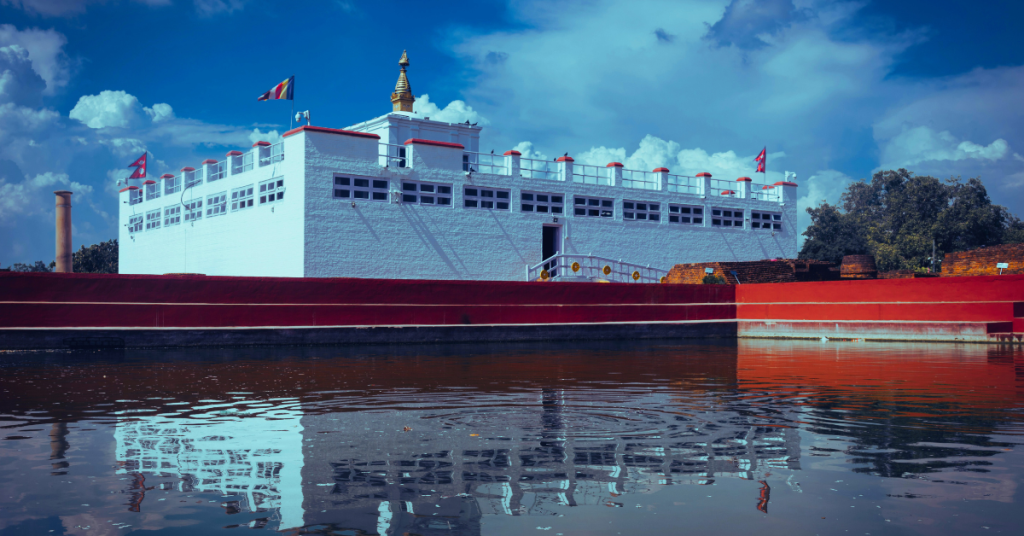
Lumbini, a UNESCO World Heritage Site, is one of the most revered pilgrimage destinations for Buddhists worldwide. Located in the Rupandehi district of Nepal, this sacred site is the birthplace of Siddhartha Gautama, who later became Gautama Buddha, the founder of Buddhism. The serene surroundings, ancient monuments, and historical significance of Lumbini make it a spiritual haven and an important cultural landmark.
Unique Features
Lumbini is not only a site of immense spiritual importance but also home to an array of architectural and cultural treasures. Key features include:
- Maya Devi Temple: The centerpiece of Lumbini, the Maya Devi Temple is the exact spot where Queen Maya Devi is believed to have given birth to Siddhartha. Inside the temple, a sacred marker stone and ancient bas-reliefs depict the moment of the Buddha’s birth, making it the focal point for pilgrims and tourists alike.
- The Sacred Garden: Surrounding the Maya Devi Temple is the Sacred Garden, which includes the Ashoka Pillar erected by Emperor Ashoka in the 3rd century BC to commemorate his visit to Lumbini. The garden is an idyllic and serene area where visitors can reflect and meditate, adding to the spiritual atmosphere of the site.
- The Puskarini Holy Pond: This is the pond where Queen Maya Devi is believed to have bathed before giving birth to Siddhartha, and where the newborn Buddha was also given his first ritual bath. The pond remains an important part of the site’s religious significance.
- Monastic Zone: The Lumbini complex is home to various monasteries built by Buddhist communities from around the world. Each monastery reflects the unique architectural and spiritual styles of its country of origin, making the monastic zone a global center of Buddhist culture.
- Ashoka Pillar: Standing tall in the Sacred Garden, this pillar, inscribed with Emperor Ashoka’s edicts, is one of the oldest and most important archaeological remnants linking Lumbini to its Buddhist heritage.
Experiences for Travelers
Lumbini offers a rich, spiritual experience, combining history, culture, and tranquility. Travelers can engage with the site in several meaningful ways:
- Spiritual Pilgrimage: For Buddhist pilgrims, Lumbini is a place to walk in the footsteps of the Buddha. Travelers can meditate, offer prayers, and participate in rituals at the sacred sites, deepening their spiritual connection to the birthplace of the Enlightened One.
- Exploring the Maya Devi Temple Complex: Visitors can explore the ruins of ancient monasteries and stupas that surround the Maya Devi Temple, learning about the history and evolution of Buddhist architecture and culture.
- Visiting International Monasteries: The monastic zone of Lumbini hosts monasteries from countries like Japan, China, Thailand, and Sri Lanka. Each monastery is uniquely designed, representing the architectural and cultural styles of their respective countries, providing a glimpse of global Buddhist traditions in one place.
- Meditation and Peaceful Retreats: The tranquil environment of Lumbini is perfect for meditation and mindfulness practices. Various centers around the complex offer meditation retreats and courses, allowing travelers to connect with their inner peace in the birthplace of Buddha.
- Lumbini Museum: Visitors interested in the archaeological and historical aspects of Lumbini can visit the Lumbini Museum, which houses a collection of ancient artifacts, religious texts, and detailed accounts of Lumbini’s evolution as a pilgrimage site.
8. Sagarmatha National Park
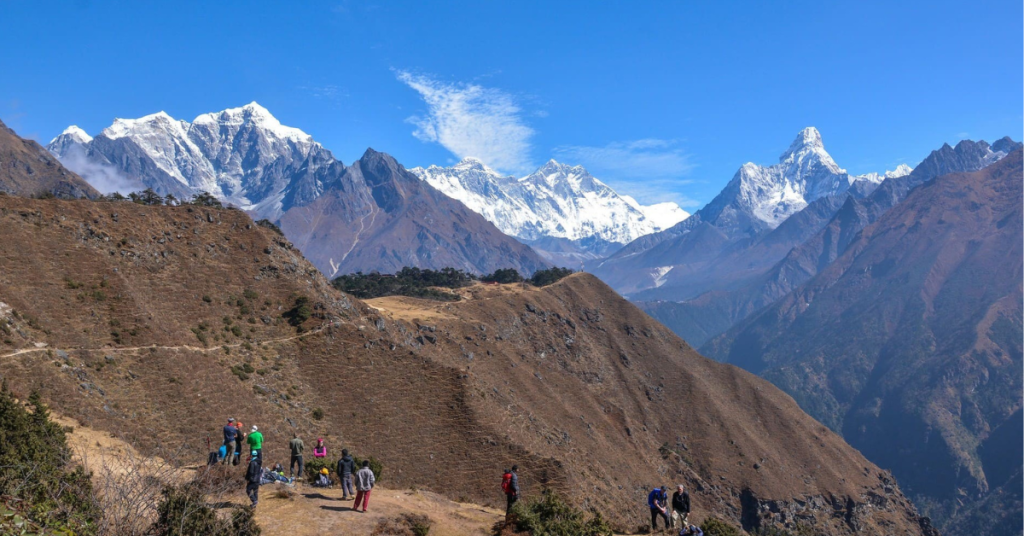
Sagarmatha National Park holds immense global significance as it protects the natural habitat of the highest mountain in the world, Mount Everest, which stands at 8,848 meters. Beyond its towering peaks, the park is home to an array of wildlife, including rare and endangered species like the snow leopard, red panda, and Himalayan tahr. The park is also a key cultural region, inhabited by the Sherpa people, whose unique culture and spiritual traditions are closely tied to Tibetan Buddhism and the mountains they revere. The park’s designation as a UNESCO World Heritage Site underscores its importance for both natural conservation and cultural heritage.
Unique Features
Sagarmatha National Park is rich in both natural and cultural treasures, offering visitors a chance to explore the wonders of the Himalayas while experiencing the Sherpa way of life. Some of its key features include:
- Mount Everest: The park is world-renowned for being the home of Mount Everest, the highest point on Earth. Thousands of trekkers and mountaineers come to the region every year, either to climb the mountain or trek to Everest Base Camp, experiencing unparalleled views of this natural icon.
- Gokyo Lakes: This chain of six glacial lakes is one of the highest freshwater lake systems in the world and provides stunning, reflective views of the surrounding snow-capped mountains. It is also a sacred site for both Buddhists and Hindus.
- Tengboche Monastery: Perched on a ridge with spectacular views of Everest, this Buddhist monastery is the spiritual heart of the Khumbu region. It is an important site for the Sherpa community and a highlight for trekkers seeking to learn about the local culture.
- Biodiversity: Sagarmatha National Park is home to a wide variety of plant species and wildlife, including rhododendron forests, Himalayan black bears, and snow leopards. The park’s altitude range from 2,845 meters to the summit of Everest creates diverse ecosystems, from temperate forests to alpine and glacial landscapes.
- Glaciers and Icefalls: The park’s rugged terrain is sculpted by glaciers, and one of the most dramatic features is the Khumbu Icefall, a constantly shifting, icy maze that mountaineers must navigate to ascend Everest. These glaciers feed into the Dudh Kosi River, creating a stunning visual spectacle for visitors.
Experiences for Travelers
Sagarmatha National Park offers unparalleled opportunities for adventure, cultural immersion, and natural exploration. Visitors can experience the majesty of the Himalayas while engaging with the local Sherpa culture.
- Trekking to Everest Base Camp: One of the most iconic trekking routes in the world, the Everest Base Camp trek takes adventurers through breathtaking valleys, forests, and Sherpa villages, offering close-up views of Everest and other towering peaks. The journey typically includes visits to the famous Tengboche Monastery and stunning viewpoints like Kala Patthar.
- Wildlife Observation: With a variety of rare species calling the park home, Sagarmatha is an excellent destination for wildlife enthusiasts. The chance to spot Himalayan tahr, snow leopards, or even the elusive red panda adds an extra layer of excitement to the journey.
- Sherpa Culture and Festivals: Travelers can immerse themselves in the rich Sherpa culture by visiting local villages, interacting with residents, and witnessing their religious ceremonies. If visiting in October, you may catch the Mani Rimdu festival at Tengboche Monastery, where monks perform masked dances and offer prayers for peace and prosperity.
- Photography and Scenic Flights: For those who prefer a less physically demanding way to see Mount Everest, scenic helicopter flights offer an unforgettable view of the Himalayas from the sky. Photographers will also find endless opportunities to capture stunning landscapes, particularly at sunrise and sunset.
Mountain Climbing and Expeditions: For experienced climbers, Sagarmatha National Park is the gateway to some of the most challenging and rewarding ascents in the world. Beyond Everest, the region offers other peaks, such as Lhotse and Ama Dablam, that draw skilled mountaineers seeking new challenges.
9. Rara National Park
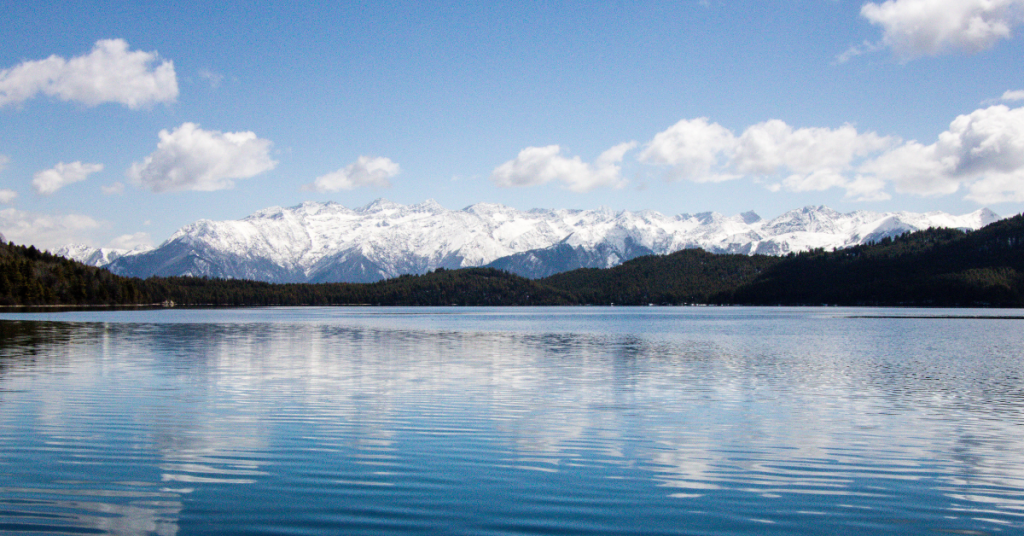
Rara National Park is Nepal’s smallest national park and a hidden gem in the western region. Located in the remote northwest corner of Nepal, this park is home to Rara Lake, the country’s largest freshwater lake, which sits at an elevation of 2,990 meters. The park is a paradise for nature lovers, featuring diverse species of flora and fauna, some of which are endemic to the region and wildlife, including the elusive red panda, Himalayan black bear, and musk deer and various bird species as Rara itself if a Sanctuary for migratory birds. Visitors can enjoy trekking, camping, and exploring the serene landscapes while immersing themselves in the tranquility of Rara National Park.
Unique Features
Rara National Park is distinguished by its remarkable natural features and diverse wildlife. Some of the park’s most notable aspects include:
- Rara Lake: The centerpiece of the park, Rara Lake, is Nepal’s largest lake, spanning 10.8 square kilometers. The crystal-clear waters of the lake reflect the surrounding snow-capped peaks, creating a mesmerizing visual experience. Rara Lake is also home to several species of fish, including the snow trout, and attracts migratory birds during the winter months.
- Diverse Ecosystems: The park’s altitude ranges from 1,800 meters to 4,087 meters, resulting in a wide variety of ecosystems. Visitors will encounter everything from temperate forests of pine, spruce, and fir to alpine meadows and grasslands. This diversity supports an equally diverse range of wildlife, making the park a hotspot for biodiversity.
- Endemic Species: Rara National Park is home to several species found only in this region, including rare plants and animals. The park provides refuge to endangered species like the red panda, Himalayan goral, and the elusive snow leopard. Birdwatchers will also find the park a paradise, with sightings of Himalayan monals, pheasants, and other high-altitude species.
- Solitude and Serenity: Due to its remote location, Rara National Park sees far fewer visitors than other national parks in Nepal, making it an ideal destination for those seeking solitude and a deep connection with nature. The park’s unspoiled beauty and lack of crowds offer a peaceful retreat for trekkers and explorers.
Experiences for Travelers
Rara National Park provides a unique set of experiences for travelers, combining natural exploration with cultural immersion in the remote region of northwestern Nepal.
- Trekking and Hiking: The journey to Rara National Park is an adventure in itself. The Rara Lake trek takes visitors through remote villages, alpine meadows, and forests, offering spectacular views of the Himalayan landscape. The trek typically begins in Jumla and can take 8 to 10 days, providing a deep sense of immersion in the natural surroundings.
- Boating on Rara Lake: Once at the park, travelers can enjoy boating on the tranquil waters of Rara Lake. The serene setting, with snow-covered mountains and dense forests as a backdrop, creates an unforgettable experience. Boating is a peaceful way to soak in the beauty of the lake and observe the wildlife along its shores.
- Wildlife Viewing: Rara National Park is a prime destination for wildlife enthusiasts. The park’s diverse habitats support a variety of animals, including the Himalayan black bear, musk deer, and snow leopard. Birdwatchers can also enjoy sightings of the park’s many bird species, especially during the migratory seasons when rare birds visit the lake.
- Cultural Immersion: Visitors to Rara National Park will also have the chance to interact with the local communities living in the surrounding areas. The region is home to several ethnic groups, including the Thakuri and Jumli people, who maintain traditional ways of life. Travelers can experience local customs, food, and hospitality, adding a rich cultural layer to their visit.
Photography: With its stunning landscapes, diverse wildlife, and serene lake, Rara National Park is a paradise for photographers. From sunrise over Rara Lake to the majestic views of the snow-capped Himalayas, the park offers endless opportunities for capturing breathtaking shots.
10. Chitwan National Park

Chitwan National Park is Nepal’s one of the oldest natural heritage sites. Established in 1973, this park shelters the endangered one-horned rhinoceros and Royal Bengal tiger. The park is also home to sloth bears, gharials, and wild elephants. Birds such as kingfisher, Bengal floricans, grass warblers, storks, egrets, etc., are found in the park. The park is also home to key conservation programs that protect vulnerable ecosystems and species. Its location in the Terai region makes it a crucial area for wildlife, linking India and Nepal’s natural habitats.
Unique Features
Chitwan National Park is characterized by its diverse ecosystems and extraordinary wildlife. Key features of the park include:
- One-Horned Rhinoceros: Chitwan is famous for its population of the rare one-horned rhinoceros. The park’s efforts to protect these magnificent creatures have led to a significant increase in their numbers, and it remains one of the best places in the world to see them in their natural habitat.
- Bengal Tiger: The park is one of the last remaining refuges for the Bengal tiger. While sightings are rare, the knowledge that these majestic animals roam the jungle adds to the thrill of exploring Chitwan.
- Gharial Crocodiles: Chitwan is home to the critically endangered gharial crocodile, known for its long, slender snout. These unique reptiles can be found basking on the banks of the Rapti and Narayani rivers.
- Elephant Breeding Center: The park’s elephant breeding center is a fascinating place to visit. It offers insights into the conservation and protection of elephants, while visitors can observe baby elephants and learn about their care.
- Rich Birdlife: With over 500 species of birds, including hornbills, kingfishers, and parakeets, Chitwan is a paradise for birdwatchers. The park’s wetlands and rivers attract a variety of migratory birds, making it a prime location for birding throughout the year.
- Dense Forests and Grasslands: The park’s landscape is a mix of dense Sal forests, riverine jungles, and open grasslands, creating a diverse environment that supports a wide range of plant and animal life.
Experiences for Travelers
Chitwan National Park offers a variety of thrilling activities and experiences for travelers, allowing them to immerse themselves in the natural wonders of the jungle.
- Jungle Safari: One of the most popular activities in Chitwan is the jungle safari, which can be done on the back of an elephant, in a jeep, or on foot. These safaris offer the chance to spot a variety of wildlife, including rhinos, tigers, leopards, deer, and more. The guided tours provide insights into the park’s ecosystems and the behavior of its inhabitants.
- Canoeing on Rapti River: A canoe ride on the Rapti River is a peaceful way to explore the park’s waterways while observing crocodiles, water birds, and other wildlife along the riverbanks. The slow pace of the canoe allows for quiet wildlife observation and an intimate connection with nature.
- Bird Watching: With its rich avian population, Chitwan is a haven for birdwatchers. Early morning bird-watching tours take visitors to prime locations where they can spot both local and migratory species in their natural habitats.
- Elephant Bathing: For a unique and playful experience, visitors can participate in elephant bathing. This involves helping to bathe elephants in the river, splashing around with these gentle giants, and creating unforgettable memories.
- Village Tours and Tharu Culture: Visitors can take guided tours of the local Tharu villages to learn about the indigenous Tharu community, their customs, traditions, and lifestyle. The Tharu people have lived in harmony with the jungle for centuries, and their culture is an integral part of the Chitwan experience. Travelers can enjoy traditional Tharu dance performances and sample local cuisine.
Nature Walks: For those who prefer a quieter, more immersive experience, nature walks through the park’s trails offer an opportunity to explore the flora and fauna at a slower pace. Accompanied by knowledgeable guides, travelers can learn about the medicinal plants, wildlife tracks, and ecosystems that thrive in the park. .
Conclusion
Nepal’s top 10 UNESCO World Heritage Sites offer a profound journey through time, culture, and nature. From the sacred temples of the Kathmandu Valley to the serene landscapes of Lumbini and the wild, untouched beauty of Sagarmatha and Chitwan National Parks, each site carries its own significance and wonder.
Exploring these landmarks allows travelers to experience the essence of Nepal, immersing themselves in the country’s vibrant traditions, architectural marvels, and breathtaking landscapes. Whether you’re seeking yoga trek, spiritual enlightenment, historical insights, or natural beauty, these heritage sites are a testament to Nepal’s enduring legacy and a source of inspiration for generations to come. Visiting these treasures is more than a journey through space; it’s a journey into the heart and soul of Nepal.Ready to explore these incredible UNESCO World Heritage Sites in Nepal? Book your trip today by clicking here.

